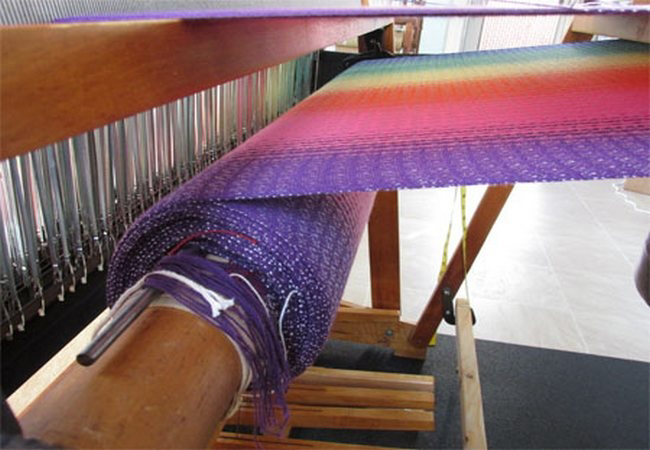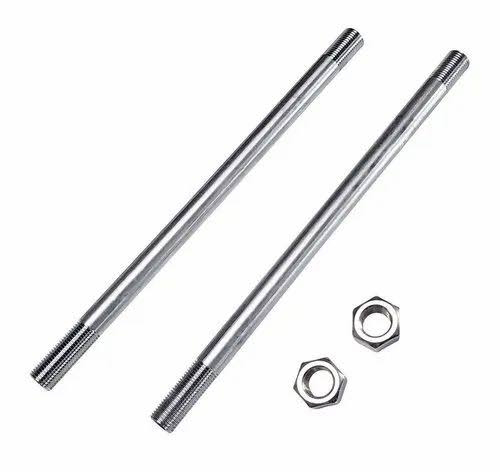Important parts of loom:-
Important parts of looms :-
Earlier brief explanation of some part is given, now the some more parts will be explained as follows.
(6) WARP BEAM:-
This also known as weaver's beam. It is fixed at the back of the loom. The warp sheet is wound on this beam. It controls the warp and releases at time of weavning as needed.The length of warp in the beam.
(7) BACK BEAM:-
This is also known as the back rest . It is the placed above the weavers beam . It may be fixed or floating type. In the first case the back rest merely acts as guide to the warp sheet coming from the weavers beam. In the second case it is both as guide and as a sensor for sensing warp tension.
Image of path of warp showing back rest(back beam).and breast beam.
(8) BREAST BEAM:-
It is also known as the front rest
As shown in above figure (image). It is placed at the front of the loom and act as a guide for the cloth being wound on the cloth roller. The front rest together with the back rest helps to keep warp yarns and cloth in horizontal position and also maintain proper tension to facilitate weaving .
(9) CLOTH BEAM ( CLOTH ROLLER) :-
The woven cloth is wound on this roller. This roller is placed below the front rest. It is operated manually at the completion of certain length of cloth.
Image of cloth beam. Ref textile tutorials.
(10) HEDDLES (HEALD):-
A heddle is wire with a hole or eye in its centre through which a warp yarn passes towards the cloth fell and are in two or more harness (shaft).
Ref:-https://www.textileschool.com.
(11) HARNESS (HEALD SHAFT) :-
A harness is frame to hold the HEDDLES (Heald) , Its position, the number of harness, and the warp yarns that are controlled by each harness determines the weave pattern. The more harness or shaft of loom has the more designs possibilities we will have. Most larger loom have four harness and table looms have only one, however loom has upto 16 harness available.
(12) LEASE RODS:-
Lease rods are used to separate the warp yarns forming shed and aiding the hand loom in keeping the warp yarns separated and in order. It decreases the electricity and friction during weaving which is generally generated due to up and down movement of warp for shed formation. Lease rods were found in some forms on every types of improved loom and their use. It is made of wooden , glass rods, metal, or nylon. It is set between the back rest and the heddle shaft. Alternately warp threads can be kept separate by passing over and under these rods.
Image of lease rod. Ref by India Mart.
(14) TEMPLES:-
A temple is an adjustable stretcher , used on a loom to maintain the width of cloth and improves the edge of a woven fabric. They devide at the edge of the cloth , which supports to maintain fixed dimension with and hold the fabric to move towards the back direction after beat up process.
Image of temple. Ref by textile coach.
FUNCTION:-
During the process of weaving fabric can decrease in width (drawn in) due to the interlacement of the warp and weft material. Temples prevent this decreased by keeping fabrics at a fixed with, thus requiring more weft to enter the weave with each of pass of shuttle.
Fabric produce without drawin has a smoother selvedge, weft can be packed in more evenly, and warp threads are likely to break from excessive friction in the reed.
Uses of temples:-
There are two main types of temples ; metal and wooden. Both types have a shaft , whose length can be adjusted and sharp prongs at each end to attach to the fabric. Wooden temples have staight fine teeth . The teeth on metal temples are winder at the base than the on the wooden temples. Metal temples are often recommend for rugs because the size and angle of teeth are better for gripping thick edges.
To Use a temple, the length is first adjusted so that it matches the total width (or spread) of warp threads in the reed. The prongs are then inserted into the fabric, on each side , at the every edges of the cloth. The temple must be moved frequently to keep it close to the fell of cloth, where the weaving is taking place.
Some other parts which are used in handloom and power loom will come later at their use in these looms. Because they will be discussed as they appear in their respective loom and their places.
https://www.textileapexblogspot.com
Ref://en.m.wikipedia.org










Comments
Post a Comment